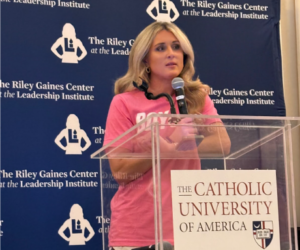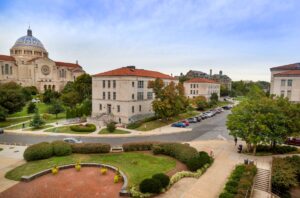Little Gidding’s Figurative Significance in Time, Prayer, and Purpose

Courtesy of CUA’s English Department
By Trinity Ruiz
On Monday, Vermillion and the Catholic University’s English department gathered for the last discussion of T.S. Eliot’s Four Quartets, “Little Gidding.” The event was graciously hosted by English professors Daniel Gibbons, Tobias Gregory, and Ryan Wilson. This being the final quartet of his anthology, the poem concerns itself with time in regards to the past, present, and future, their unification, and how “Little Gidding” contributes to this.
According to Gibbons this poem is excellent because of its capacity to “awaken” his notion of the theological, philosophical, and the historical.
The poem centers around a small anglican chapel located in Little Gidding, a small village in England. The chapel and parish represents a place where one can retreat to public and political affairs; it represents “the last refuge for someone who has lost everything,” said Gibbons.
Eliot, in this poem, tries to conceive the past and and present in a manner that enables him to hold onto tradition while embracing the importance of the present and future without the past hindering either.
Gibbons explained that Eliot’s “sense of selfhood was motivated by a desire to reconceive history and deem tradition vital without requiring one to conform to empty formalism.”
“From which purpose breaks only when it is fulfilled if at all” (l.32-33)
In this line, Eliot conveys that if there is a purpose,“it is beyond the end you figured,” saidGibbons.
Adding to this, Eliot writes a few lines later that “you are not here to verify.” (l.43) Through subjective interpretation, Eliot conveys that it is not our concern to find this purpose so that we may remove ourselves from “being trapped in the past,” saidWilson.
It is only in fulfillment that purpose is altered (l.35); therefore, one’s purpose cannot be known until it is fulfilled. This is why we are not to verify. Eliot confirms that our purpose is beyond what we can conceive. Gregory beautifully said that it is in disappointment that you are given what you need when you are able to “see its magic.”
“You are here to kneel where prayer has been valid” (l.45-46)
Gregory regarded this sentence as “the most important line” of the poem. He went on to say that “the sense of place is enormously powerful.” Though Gregory acknowledged this notion is subjective, it’s worth pondering that where one remains, figuratively or physically, according to Eliot, can validate something as powerful as prayer.
Eliot conveys that one is to kneel where prayer means something, where prayer can be validated. Because prayer is more than mere words, one is to pray where prayer is significant. Gibbons noted that Eliot “proceeds by negation” in Eliot describing what prayer is not and what it is more than, i.e. “an order of words” (l.47) and verification. Gibbons said prayer is about “assuming a certain kind of disposition.”
Gibbons elaboratedon prayer and the self-discipline that accompanies Western Christianity. Published in 1942, during the second world war, Gibbons said that in the occurrence of so much destruction and violence “how can any prayer not just ring hollow?” This is what Eliot is trying to make sense of.
“And the end of all our exploring will be to arrive where we started and know the place for the first time” (l.240-242)
This line represents that the journey Eliot conveys is endless and ever-going but is not a “journey without ends,” said Gibbons. The poem ends with optimism regarding the unclear purpose and the denying of verification in that purpose. Wilson concludedhis remarks by noting that “only by the humility of lowering yourself can you climb up.”
While this was the last discussion of the English Departments “Reading Together” series for the semester, the department welcomes you for more to come in the fall!







